Page 1 of 2
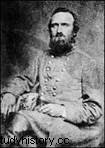 The Fierce Fighting of the “Seven Days” (June 25 – 1
st
July 1862) had ended the blockade of Richmond by the Northern Army of the Potomac, but had not put an end to all activity in the Peninsula. July was marked by a series of reconnaissance and minor skirmishes around Harrison's Landing, where McClellan's men had dug in after their retreat.
The Fierce Fighting of the “Seven Days” (June 25 – 1
st
July 1862) had ended the blockade of Richmond by the Northern Army of the Potomac, but had not put an end to all activity in the Peninsula. July was marked by a series of reconnaissance and minor skirmishes around Harrison's Landing, where McClellan's men had dug in after their retreat.
The northerner general still considered himself threatened by a numerically superior enemy, and cried out for new reinforcements. For its part, General Lee's Army of Northern Virginia saw itself in danger of being caught in the crossfire , between the Army of the Potomac on the one hand, and the Northern Army of Virginia, deployed in the north of the State and commanded by Pope, on the other hand.
The Lessons of the Seven Days
July was also a time of significant reorganisations for the two belligerents. Deciding to generalize the use of army corps, Lincoln created three new ones on July 22, and a fourth a little later. Thus was born the VII th Corps, entrusted to John Dix and operating around Norfolk, on the southern bank of the James Estuary; the VIII th , commanded by John Wool and protecting the – highly strategic – area of the Potomac Valley; the IX th , under the orders of Ambrose Burnside, including the troops stationed along the coasts of North Carolina; and the X th , bringing together the forces operating in South Carolina and Georgia, and of which Ormsby Mitchel will take command. Mitchel will die of yellow fever in October. He will be replaced by Quincy Gillmore.
L 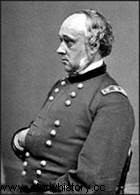 The Army of Virginia was also organized into corps, but none of the three that were formed on this occasion was going to be numbered the same as the other Union army corps. Thus, the former Mountain Department, now commanded by Franz Sigel, was to become the 1
st
Virginia Army Corps. Banks' forces would constitute the 2
th
. As for what was until then the I
st
McDowell's Army Corps, it was to be renumbered to constitute the 3
th
… For convenience, the corps of the Army of Virginia will be designated here by Arabic numerals, and the other Northern corps by Roman numerals. This provision, moreover, was only to be transitory. Finally, Lincoln appointed Henry Halleck, responsible until then for coordinating the federal forces in the West, to the post of commander in chief of the northern armies – thus ending a hiatus of four and a half months, since McClellan had left this function in March.
The Army of Virginia was also organized into corps, but none of the three that were formed on this occasion was going to be numbered the same as the other Union army corps. Thus, the former Mountain Department, now commanded by Franz Sigel, was to become the 1
st
Virginia Army Corps. Banks' forces would constitute the 2
th
. As for what was until then the I
st
McDowell's Army Corps, it was to be renumbered to constitute the 3
th
… For convenience, the corps of the Army of Virginia will be designated here by Arabic numerals, and the other Northern corps by Roman numerals. This provision, moreover, was only to be transitory. Finally, Lincoln appointed Henry Halleck, responsible until then for coordinating the federal forces in the West, to the post of commander in chief of the northern armies – thus ending a hiatus of four and a half months, since McClellan had left this function in March.
In the Southern camp, there was also going to be a major reorganization within the Army of Northern Virginia. Finally taking the time to learn the lessons of Seven Pines and the Seven Days, General Lee greatly simplified his chain of command. He took the opportunity to clean up his subordinates , dismissing those who had shown their limits during previous fights. Holmes was placed at the head of the military department of Outre-Mississippi, with Huger as inspector general of its artillery – prestigious cupboard! Magruder was also placed under Holmes, as head of the military district of Texas, New Mexico, and Arizona. As for Whiting, at least he escaped a distant post since he was assigned to the defense of Wilmington, North Carolina. In addition, the many divisions of Lee's army were divided between two wings, the left being given to Jackson and the right to Longstreet.
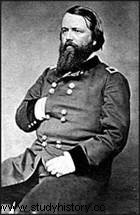 Upon his arrival in the field in mid-July, John Pope alienated the population of Virginia by a series of orders aimed directly at her. The Army of Virginia was confronted with the sporadic actions of Confederate partisans, which posed a diffuse but permanent threat to its camps and supply lines. Pope reacted to this by ordering his army to live as much as possible on the country – a provision which, two years later, was to be common, but which was still new, and relatively shocking, in 1862. partisan attacks, Pope ordered reparations to be levied on civilian property. This provision will generate so much abuse that Pope will be forced to set up patrols to arrest Union soldiers who have looted. At the same time, he forced civilians to take an oath of allegiance to the Union, or risk being driven from their homes – banished ones risking summary execution if they returned.
Upon his arrival in the field in mid-July, John Pope alienated the population of Virginia by a series of orders aimed directly at her. The Army of Virginia was confronted with the sporadic actions of Confederate partisans, which posed a diffuse but permanent threat to its camps and supply lines. Pope reacted to this by ordering his army to live as much as possible on the country – a provision which, two years later, was to be common, but which was still new, and relatively shocking, in 1862. partisan attacks, Pope ordered reparations to be levied on civilian property. This provision will generate so much abuse that Pope will be forced to set up patrols to arrest Union soldiers who have looted. At the same time, he forced civilians to take an oath of allegiance to the Union, or risk being driven from their homes – banished ones risking summary execution if they returned.
Pope was also hated by many of his officers and some of his soldiers. On July 14, 1862, he addressed to the Army of Virginia a proud proclamation which, contrary to the hopes of its author, was not designed to boost the morale of the army. It read:“I have come to you from the West, where we have always seen the backs of our enemies; of an army whose task was to seek out the enemy and defeat him wherever he was; whose strategy was attack and not defense . […] In the meantime, I would like you to put certain phrases out of your minds, which I regret to find so much in vogue among you. I constantly hear about "settling and holding strong positions", "retreat lines" and "supply bases". Let us abandon such ideas. […] Let's look ahead, not behind. Success and glory are ahead, disaster and shame lurk behind . However, the northern general was soon to experience his share of disaster and shame.
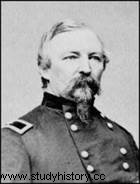 Choice Time
Choice Time
On the very day that Pope issued his fatal proclamation, he ordered his army to march south. In this he was merely carrying out Lincoln's instructions. The northern president intended to give McClellan the help he was asking for. The purpose of the maneuver was, initially, to lure Lee away from Harrison’s Landing , from where McClellan could then threaten Richmond again. At the same time, the IX th Newly created corps would go to reinforce the Army of Virginia, leaving in North Carolina only the bare minimum in troops. Eventually, the two federal armies should be able to join up in front of Richmond, totaling a workforce of around 140,000 men – 50,000 for Pope, 90,000 for McClellan. Lee, for his part, had less than 80,000 soldiers, but fortunately for him, his opponents ignored him.
The Northerners' objective was the Gordonsville rail junction , where they could cut the rail line that connected Richmond to central Virginia – the Virginia Central Railroad . Lee was informed early on of enemy movements. He sent Jackson, with Winder's (four brigades) and Ewell's (three brigades) divisions and a cavalry brigade commanded by Beverly Robertson, for a total of 14,000 men. These forces reached Gordonsville on July 19, three days before the northern vanguard (John Hatch's cavalry brigade) arrived there. Unable to destroy even a small stretch of railroad, the Blue Horsemen quickly retreated – resulting in Hatch being immediately transferred to an infantry unit.
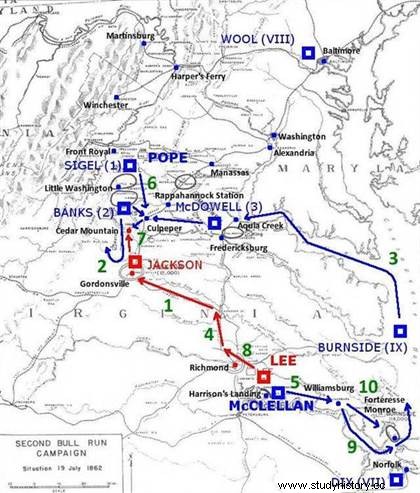 The situation in Virginia, late July - early August 1862 (author's annotations on a map of Center for Military History United States Army):
The situation in Virginia, late July - early August 1862 (author's annotations on a map of Center for Military History United States Army):
1) July 19:Jackson arrives in Gordonsville.
2) July 22:Hatch's northern cavalry picks up speed.
3) July 26:Mosby informs Lee of the transfer of the IX th Burnside's body to Aquia Creek.
4) July 27:Lee sends A.P. Hill's division to reinforce Jackson in preparation for an offensive.
5) August 3:The Army of the Potomac begins evacuating its sick and wounded.
6) August 7:Pope orders his three army corps to concentrate at Culpeper.
7) August 9:Banks and Jackson meet at Cedar Mountain, Southerners win. Jackson withdrew soon after.
8) August 13:Confident that McClellan will not attack, Lee sets out for Gordonsville with the rest of his army.
9) August 14:Army of the Potomac begins to leave the Peninsula.
10) The th IV Corps remains in place to protect Fortress Monroe.
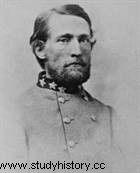 However, this movement had led to the discovery that the Confederate army was, at least in part, far from Richmond . The order was therefore given to McClellan to take advantage of the situation by resuming the offensive against the southern capital. But the general objected that he lacked troops for this, demanding 50,000 more men to be able to attack. When it became clear that McClellan would not budge, Lincoln and Halleck decided to end the unsuccessful Peninsula campaign . On August 3, the Army of the Potomac was ordered to prepare to leave Harrison's Landing for Williamsburg. From there, it would be transported by boat to Aquia Creek on the Potomac, downstream from Washington. Only the IV
th
Corps would remain in the Peninsula to protect Fortress Monroe.
However, this movement had led to the discovery that the Confederate army was, at least in part, far from Richmond . The order was therefore given to McClellan to take advantage of the situation by resuming the offensive against the southern capital. But the general objected that he lacked troops for this, demanding 50,000 more men to be able to attack. When it became clear that McClellan would not budge, Lincoln and Halleck decided to end the unsuccessful Peninsula campaign . On August 3, the Army of the Potomac was ordered to prepare to leave Harrison's Landing for Williamsburg. From there, it would be transported by boat to Aquia Creek on the Potomac, downstream from Washington. Only the IV
th
Corps would remain in the Peninsula to protect Fortress Monroe.
For his part, Robert Lee was faced with a crucial choice. Pope's advance, however timid, presented him with a tempting opportunity by bringing the Army of Virginia within reach. On the other hand, the Army of the Potomac still posed a threat, although Lee doubted that McClellan was also eager to attack. Taking his army away from Richmond, leaving it exposed to McClellan's forces, still posed a significant risk. On July 26, Lee received vital information from a cavalry officer, one of General Stuart's best scouts, Captain John Singleton Mosby. The latter had been captured shortly before, but had just been released as part of a prisoner exchange. An expert in intelligence, Mosby had noted, on the boat which brought him back to the southern lines, numerous transport ships going up the Potomac and the Chesapeake Bay. He deduced that Pope was being reinforced with troops transferred from North Carolina, a deduction which turned out to be correct.
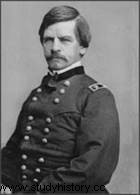 These elements proved decisive. If Lee struck the Army of Virginia before it was reinforced by the IX
th
Body, he had a chance to destroy . Admittedly, he was taking a risk by leaving Richmond. But if he stayed there to wait for Pope and McClellan to attack him together, he would have almost no chance of winning. So he opted for the offensive. As early as July 27, he sent the division of A.P. Hill, seven brigades and 10,000 men, reinforce Jackson. Lee stepped up reconnaissance to make sure McClellan wouldn't budge, which became increasingly likely after August 3, when the Army of the Potomac began evacuating its wounded and sick. However, final confirmation would only come with the departure of the first northern troops on August 14.
These elements proved decisive. If Lee struck the Army of Virginia before it was reinforced by the IX
th
Body, he had a chance to destroy . Admittedly, he was taking a risk by leaving Richmond. But if he stayed there to wait for Pope and McClellan to attack him together, he would have almost no chance of winning. So he opted for the offensive. As early as July 27, he sent the division of A.P. Hill, seven brigades and 10,000 men, reinforce Jackson. Lee stepped up reconnaissance to make sure McClellan wouldn't budge, which became increasingly likely after August 3, when the Army of the Potomac began evacuating its wounded and sick. However, final confirmation would only come with the departure of the first northern troops on August 14.
The Army of Virginia was not only tasked with marching on Gordonsville. It was also to cover the approaches to Washington and maintain control of the Shenandoah Valley. For this reason, its different components were very dispersed . The 1 st Corps camped not far from Front Royal, in the Valley. The 2 th was a little further east, scattered between Little Washington and Culpeper. The 3 th was on the other hand much more distant, having remained around Fredericksburg. Pope was again ordered to march on Gordonsville, this time to divert Confederate attention while McClellan evacuated Harrison's Landing. On August 6, Pope converged his forces on Culpeper, from where he would then march towards Gordonsville.
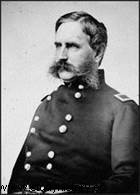 The Battle of Cedar Mountain
The Battle of Cedar Mountain
His orders, however, were not carried out as they should have been . Sigel wasted a whole day asking his superior for confirmation of his instructions, and which route he was to march to Culpeper - when there was only one. So much so that the 1 st Corps was not going to play any role in the upcoming engagement. As for the 3 th Corps, it meandered on the difficult roads that skirted the Rappahanock, led by the division of James Ricketts. Banks, for his part, struggled to muster his own strength. On August 8, he had barely 8,000 men at Culpeper:Christopher Augur's division, three brigades strong, and a fraction - two brigades - of that of Alpheus Williams.
Well informed by the partisans and the local population, Jackson was quickly informed of the concentration in progress. This time rested and recovered from the apathy that had been his during the Seven Days, he did not hesitate and decided to attack Banks before the rest of the northern army joined him at Culpeper. On August 7, he marched north with the bulk of his forces, about 17,000 men. Warned by his cavalry pickets, Banks soon learned that his enemy was vastly outnumbered. Understanding that he had no chance of winning if he remained on the defensive, the northern general opted for a reckless solution:go to meet Jackson . Banks had other motivations:beaten soundly by Jackson at Front Royal and at Winchester two and a half months earlier, he was burning for revenge. Her decision was undoubtedly a bold one, and she almost succeeded.
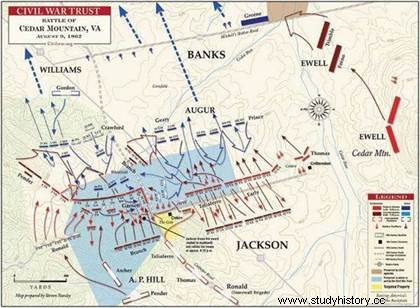 Battle of Cedar Mountain, August 9, 1862. Map of Civil War Preservation Trust.
Battle of Cedar Mountain, August 9, 1862. Map of Civil War Preservation Trust.
On August 9, the northern troops leave towards the southwest. While advancing slowly towards Culpeper, the Confederates established contact, in the afternoon, with elements of the Federal cavalry deployed near Cedar Mountain , a height that dominates the surroundings. The leading brigade, that of Jubal Early, pushes them back only to find that behind them, the northern artillery is present in force. Early settles along a path connecting the Crittenden farm to the house of a certain Reverend Slaughter – a surname which also means “massacre” in English. In front of the Southerners stretches a vast field of harvested wheat which slopes gently towards a small stream, the Cedar Run. Ewell sends the rest of his division – the Louisiana Tigers and the Trimble Brigade – to move to his right on Cedar Mountain, a maneuver that will take some time.
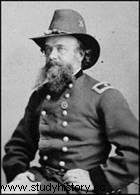 Winder's division, meanwhile, takes up position to the left of Early:between William's brigade Taliaferro and that of Thomas Garnett, Winder installs his artillery, and the latter immediately engages in a sustained duel with his northern counterpart. While the southern general is supervising the placement of his batteries, a Yankee shell explodes right next to him. The entire left side of his body was horribly shredded, injuries that Winder would only survive for a few hours. Taliaferro replaces him, but he is unaware of Jackson's plans and finds that the division is not yet ready :the Stonewall brigade is in retreat, the flank of the T. Garnett brigade is unprotected, and the division of A.P. Hill is even further back. This is precisely the moment Banks chooses to launch his attack.
Winder's division, meanwhile, takes up position to the left of Early:between William's brigade Taliaferro and that of Thomas Garnett, Winder installs his artillery, and the latter immediately engages in a sustained duel with his northern counterpart. While the southern general is supervising the placement of his batteries, a Yankee shell explodes right next to him. The entire left side of his body was horribly shredded, injuries that Winder would only survive for a few hours. Taliaferro replaces him, but he is unaware of Jackson's plans and finds that the division is not yet ready :the Stonewall brigade is in retreat, the flank of the T. Garnett brigade is unprotected, and the division of A.P. Hill is even further back. This is precisely the moment Banks chooses to launch his attack.
At 5 p.m., the Augur Division began to cross the field separating it from the Early and Taliaferro Brigades. George Greene's small brigade having been left in reserve to cover the northern left wing, the attack was led by those of John Geary and Henry Prince. The determination of the assault surprises the Confederates, who begin to retreat . However, as the Federals advanced, they found themselves in the crossfire of the artillery placed at both ends of the southern line. The guns which emptied their canisters on them wreaked havoc among the Blues, the losses accumulated, Augur himself was wounded as well as his two brigade commanders. Early manages to rally his men and the attack is finally repelled.
It's different on the southern left wing. The Williams Division also went on the attack, but their advance was covered by the forest and the lay of the land. When she emerges from the underbrush, she is already dangerously close to the T. Garnett Brigade. While Samuel Crawford assaulted him head-on, George Gordon launched into a successful flanking move, with no one there to cover the southern left. The maneuver surprises the defenders, who try to resist as best they can. We come to body to body. The Federals have the upper hand and the southern brigade is routed. Panic spreads to the Stonewall Brigade , which has just arrived and is not yet ready. Jackson had to pull back his artillery to avoid being overwhelmed, then he set out to rally his troops. Brandishing a rusty sword for lack of use and therefore stuck in its sheath, the whimsical southern general manages to produce the desired effect on the morale of his men.
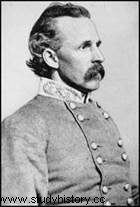 The reformed Stonewall Brigade thus manages to repel the assailant, and de Chasse becomes a Huntress. In doing so, she soon finds herself isolated and counter-attacked in turn, but the Confederate left is saved. The A.P. Hill division had time to arrive, and Jackson will use it to the best of its ability to turn the tide of the battle . Williams' division was soon broken again in its tracks by the brigades of James Archer and Dorsey Pender. Early and Taliaferro go on the attack with the support of Edward Thomas on their right. Williams' division in full retreat left the right flank of Augur's division exposed, which was finally assaulted by Branch's brigade. The northerner defeat will be consumed when Trimble, descending from Cedar Mountain, pushes back the Greene brigade. At 7 p.m., Banks is in full retreat. The sacrifice of a detachment of northern cavalry allows him to gain a few precious minutes and escape destruction. The late arrival of Ricketts' division, around 10 p.m., put an end to the pursuit.
The reformed Stonewall Brigade thus manages to repel the assailant, and de Chasse becomes a Huntress. In doing so, she soon finds herself isolated and counter-attacked in turn, but the Confederate left is saved. The A.P. Hill division had time to arrive, and Jackson will use it to the best of its ability to turn the tide of the battle . Williams' division was soon broken again in its tracks by the brigades of James Archer and Dorsey Pender. Early and Taliaferro go on the attack with the support of Edward Thomas on their right. Williams' division in full retreat left the right flank of Augur's division exposed, which was finally assaulted by Branch's brigade. The northerner defeat will be consumed when Trimble, descending from Cedar Mountain, pushes back the Greene brigade. At 7 p.m., Banks is in full retreat. The sacrifice of a detachment of northern cavalry allows him to gain a few precious minutes and escape destruction. The late arrival of Ricketts' division, around 10 p.m., put an end to the pursuit.
Lee and the rest of the Army of Northern Virginia arrive in Gordonsville on August 15. Without waiting, the southern general decides to maneuver to bypass Pope's left wing . At that time, the two armies had roughly equivalent manpower, of the order of 55,000 men each. The northern army is firmly entrenched along the Cedar Creek River. Lee's general idea is to turn this position by taking advantage of the cover provided by a height, Clark's Mountain, and to cross the Rapidan below its confluence with Cedar Creek. To make sure of the feasibility of the thing, Lee sends in scouting cavalry of Stuart. The latter now forms a division in its own right, made up of the brigades of Robertson and Fitzhugh Lee – the latter being a nephew of Robert.
Maneuver War in Virginia
However, this plan will fall short. Demonstrating a levity that would still catch him out several times later, J.E.B. Stuart let himself be imprudently surprised, on the night of August 17 to 18, by a raid by northern cavalry against his own camp. Stuart manages to escape, not without seeing his pride somewhat damaged when the Feds seize some of his personal effects. There is much worse, however:one of his aides-de-camp was taken prisoner, and he was carrying an order from Lee detailing the planned operations. Pope immediately exploited this information and, on August 20, thwarted the Southern maneuver retreating a few kilometers to the northeast, behind the Rappahannock.
The same day, the Army of the Potomac begins to evacuate the Peninsula. The V th Body of Fitz-John Porter is the first concerned and, on August 22, it is complete at Aquia Creek. Will follow, in order, the III ème , the VI th and the II th Corps, the latter beginning its movement on 26 August. As soon as he landed, Porter was ordered to join Pope on the Rappahannock. While the division of Pennsylvania Reserves is transferred to the 3 th Body of McDowell, the V th Corps reinforces the northern defenses, bringing the total strength of the Army of Virginia to nearly 75,000 men. For General Lee, time is running out :if he takes too long to attack, his opponent will be dangerously outnumbered. He therefore instructed Stuart to multiply reconnaissance to detect a weak point in the northern line.
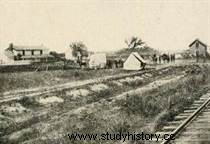 August 22 offers the leader of the Southern cavalry the opportunity to avenge the affront he suffered a few days earlier. Outflanking the federal right wing, he pushes to Pope's headquarters. The northerner general is absent, but Stuart has the satisfaction of grabbing his… parade uniform. The Confederate raid, however, is less futile than it seems:it shows that the northern right is "in the air" and can be easily turned. An idea even bolder than the previous one then germinated in Lee's mind:completely bypass the enemy army to end up in their rear . This was not a simple flanking attack:the Confederate army would have to climb the Rappahanock in a northerly direction, take the narrow valley that separates the Blue Ridge range from the Bull Run mountains, before veering towards the east to emerge at the height of Manassas after having crossed the cluse of Thoroughfare.
August 22 offers the leader of the Southern cavalry the opportunity to avenge the affront he suffered a few days earlier. Outflanking the federal right wing, he pushes to Pope's headquarters. The northerner general is absent, but Stuart has the satisfaction of grabbing his… parade uniform. The Confederate raid, however, is less futile than it seems:it shows that the northern right is "in the air" and can be easily turned. An idea even bolder than the previous one then germinated in Lee's mind:completely bypass the enemy army to end up in their rear . This was not a simple flanking attack:the Confederate army would have to climb the Rappahanock in a northerly direction, take the narrow valley that separates the Blue Ridge range from the Bull Run mountains, before veering towards the east to emerge at the height of Manassas after having crossed the cluse of Thoroughfare.
To prevent Pope from suspecting something and surprising the Southerners in the middle of this perilous maneuver, it will have to be done in two stages. Jackson will leave first, followed two days later by Longstreet and the rest of the army. To divert the attention of the Feds , a series of small demonstrations are conducted, from August 22 to 25, at Rappahannock Station – the place where the railroad of the Orange &Alexandria Railroad spans the river. Pope takes the bait:convinced that Lee is preparing an attack in this sector, he has his defenses reinforced there. The northern general even considered going on the attack, but he was finally dissuaded by heavy rains which swelled the waters of the Rappahannock.
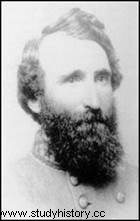 Panic in Manassas
Panic in Manassas
The left wing, commanded by Jackson, went into action at dawn on August 25 with the utmost discretion. As usual, Jackson did not inform his division commanders of their destination. But this time the operation was carefully planned and runs perfectly. Later, Taliaferro would summarize the orders he had received in these terms:“Walk to the crossroads; a staff officer will tell you which direction to take; and so on until the next junction, where you will find a courier with a sealed order telling you the route to follow . The southern column stretches for several kilometers, but it progresses without encountering opposition. In the evening, she has already traveled more than forty kilometers. She will do sixty more the next day – double what is generally considered a normal daily progression. Once again, Jackson's infantry have earned their nickname "foot cavalry"!
Late afternoon of August 26, lead elements cut the Orange &Alexandria Railroad at Bristoe Station, after covering almost a hundred kilometers in 36 hours. Continuing his momentum, Jackson, who had been joined a few hours earlier by Stuart, launched the Trimble brigade on the huge depot that the northern forces installed in Manassas. She captured several hundred men, eight pieces of artillery, heaps of food and equipment, as well as about 200 fugitive slaves. The Confederates, who had only brought three days of rations with them, took the opportunity to feast throughout the day of the 27th, before setting fire to everything they could not carry. The day before, Longstreet had set off in turn to join them, unmolested – but with less speed.
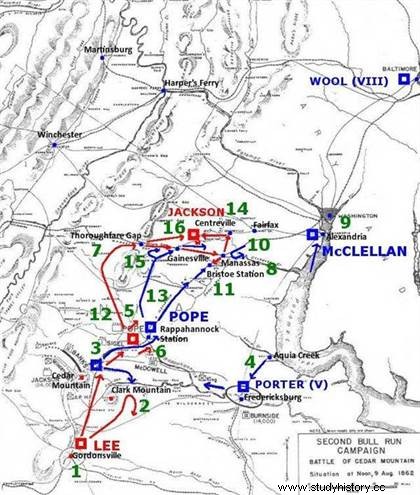 Strategic situation in Virginia during the second half of August 1862 (author's annotations on a map of Center for Military History United States Army):
Strategic situation in Virginia during the second half of August 1862 (author's annotations on a map of Center for Military History United States Army):
1) August 15:Lee and the main body of the Army of Northern Virginia arrive in Gordonsville.
2) August 18:Stuart is surprised by a Union cavalry raid while probing the Union left.
3) August 20:Pope thwarts Lee's maneuver by retreating behind the Rappahannock.
4) August 22:the V th Corps landed at Aquia Creek and immediately left to reinforce the Army of Virginia.
5) August 22:Stuart conducts reconnaissance against the northern right and discovers that it is unprotected.
6) August 22-25:In anticipation of his flanking maneuver, Lee launches a series of diversionary attacks at Rappahannock Station.
7) August 25:Jackson begins his march to Manassas via Thoroughfare Lock.
8) 26 août :Jackson prend Manassas et Bristoe Station après avoir couvert une centaine de kilomètres en deux jours.
9) 26 août :le reste de l'armée du Potomac continue à débarquer à Washington.
10) 27 août :la brigade de G.W. Taylor est repoussée en tentant de reprendre Manassas.
11) 27 août :les divisions Hooker et Ewell s'affrontent à Bristoe Station.
12) 27 août :Lee et Longstreet se mettent en route à leur tour pour aller rejoindre Jackson.
13) 27 août :Pope ordonne à son armée de se replier jusqu'à Manassas mais néglige de bloquer la cluse de Thoroughfare.
14) 28 août :Jackson quitte Manassas et gagne une nouvelle position sur Stony Ridge.
15) 28 août :Longstreet chasse la cavalerie nordiste et la division Ricketts de la cluse de Thoroughfare, s'ouvrant un chemin pour rejoindre Jackson.
16) 28 août :pour inciter Pope à l'attaquer, Jackson intercepte la division King, déclenchant la bataille de Groveton.
De son côté, Pope ne réalise pas la situation. Croyant à un simple raid de cavalerie sur ses arrières, il fait venir de Washington un élément du VI ème Corps fraîchement débarqué, en l’occurrence la New Jersey Brigade de George W. Taylor. Naturellement, la brigade est écrasée lorsqu’elle tente, le 27 août, de déloger les Sudistes de Manassas, et Taylor est mortellement blessé. Pope comprend alors que quelque chose cloche , mais il ne sait pas exactement quoi. Il est mal renseigné, car sa cavalerie est dispersée à raison d’une brigade pour chacun de ses trois corps d’armée. Le III ème Corps, partiellement débarqué à Alexandria, est en train de venir le rejoindre sur le Rappahannock. Pope ordonne à sa division de tête, celle de Hooker, de faire demi-tour pour aller voir ce qu’il en est du côté de Manassas. Dans l’après-midi, Hooker accroche brièvement la division Ewell, que Jackson a déployée à Bristoe Station pour protéger son flanc droit.
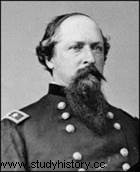 Pope obtient ainsi confirmation que c’est l’aile de Jackson toute entière qui est présente à Manassas. Parallèlement, il apprend également que Longstreet a, lui aussi, entrepris de contourner son aile droite, ne laissant que la division de R.H. Anderson comme arrière-garde. S’il est trop tard pour frapper Longstreet, en revanche, il demeure possible d’écraser Jackson tant qu’il demeure isolé. Par conséquent, Pope ordonne à toutes ses forces de converger vers cette localité, abandonnant ses positions sur le Rappahannock. Espérant prendre son ennemi au piège, il fait emprunter à ses troupes des routes différentes afin de ne lui laisser aucune échappatoire. Ce faisant, il fait transiter le 1
er
Corps de Sigel et le 3
ème
Corps de McDowell par une route qui leur permettrait de couper la cluse de Thoroughfare .
Pope obtient ainsi confirmation que c’est l’aile de Jackson toute entière qui est présente à Manassas. Parallèlement, il apprend également que Longstreet a, lui aussi, entrepris de contourner son aile droite, ne laissant que la division de R.H. Anderson comme arrière-garde. S’il est trop tard pour frapper Longstreet, en revanche, il demeure possible d’écraser Jackson tant qu’il demeure isolé. Par conséquent, Pope ordonne à toutes ses forces de converger vers cette localité, abandonnant ses positions sur le Rappahannock. Espérant prendre son ennemi au piège, il fait emprunter à ses troupes des routes différentes afin de ne lui laisser aucune échappatoire. Ce faisant, il fait transiter le 1
er
Corps de Sigel et le 3
ème
Corps de McDowell par une route qui leur permettrait de couper la cluse de Thoroughfare .
Pope tient là une occasion unique de bloquer le passage aux forces de Longstreet à peu de frais. Mais, persuadé de pouvoir écraser Jackson avant son arrivée, il néglige complètement cette opportunité . Ce sera l’une des pires erreurs commises par le commandement nordiste de toute la guerre. La seule action entreprise par les Fédéraux au niveau de la cluse de Thoroughfare sera d’y poster un régiment de cavalerie, qui en sera chassé au bout de quelques heures seulement, dans la matinée du 28 août, par les premiers éléments de Longstreet. La division Ricketts enverra quelques régiments pour soutenir les cavaliers fédéraux, mais il seront très vite dépassés en nombre et obligés de battre en retraite. Ce faisant, Ricketts laissait aux Confédérés l’opportunité d’aller rejoindre Jackson, au prix de quelques heures perdues seulement pour Longstreet.
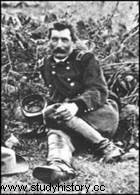 La bataille de Groveton
La bataille de Groveton
En cette même journée du 28 août, Jackson se trouve sur une nouvelle position , qu’il a occupée durant la nuit. Il s’agit d’une petite hauteur baptisée Stony Ridge, non loin de la route à péage de Warrenton et du gué de Sudley Springs – à quelques encablures, en fait, des lieux où Jackson s’est illustré treize mois auparavant lors de la première bataille de Bull Run. Le général sudiste a trouvé là, à une dizaine de kilomètres au nord-ouest de Manassas, tout ce dont il a besoin. Il est un peu plus près de Longstreet, lui-même à moins d’une journée de marche désormais. Il peut menacer le flanc de l’armée nordiste, encore en plein mouvement, sans trop s’exposer lui-même. Enfin, en cas d’attaque ennemie, sa position est suffisamment solide pour lui permettre de résister assez longtemps pour que Longstreet arrive à son secours :elle s’appuie sur le talus d’une voie ferrée inachevée, sa gauche est ancrée sur le Bull Run, et la colline dans son dos permet d’y déployer de l’artillerie.
L’après-midi est déjà bien avancé lorsque les Confédérés ont la chance de capturer une estafette porteuse d’ordres détaillés, indiquant que Pope est en train de concentrer ses forces à Manassas, ainsi que les routes suivies par ses différents corps d’armée. Or, une partie du 3 ème Corps doit justement passer par la route à péage de Warrenton , juste sous le nez des Sudistes. L’information est communiquée à Jackson alors qu’il est en train de faire la sieste. Mais le Jackson somnolent des Sept Jours est bien oublié :saisissant immédiatement l’opportunité qui lui est offerte, il ordonne à Taliaferro d’attaquer avec le soutien d’Ewell. Il craint en effet que Pope ne parvienne à s’échapper avant que Longstreet ne le rejoigne, et veut à tout prix l’empêcher de regrouper ses forces.
 Les troupes sudistes se placent en embuscade, non loin de la route, mais rien ne vient. Ce n’est que vers 18 heures qu’une colonne nordiste débouche enfin au pied de Stony Ridge :c’est la division de Rufus King, qui constitue l’aile gauche du 3
ème
Body. Elle est forte de quatre brigades commandées respectivement par John Hatch, John Gibbon, Abner Doubleday et Marsena Patrick. Leur supérieur, King, est absent, ayant été victime d’une crise d’épilepsie quelques heures plus tôt – tant et si bien que ses subordonnés vont devoir coordonner leurs efforts eux-mêmes, avec plus ou moins de bonheur, pour faire face à l’attaque qui les vise. À la tête du 3
ème
Corps, McDowell aussi est absent, s’étant semble-t-il perdu. Les forces nordistes vont donc manquer cruellement de coordination dans les combats à venir, et ce n’est qu’un début.
Les troupes sudistes se placent en embuscade, non loin de la route, mais rien ne vient. Ce n’est que vers 18 heures qu’une colonne nordiste débouche enfin au pied de Stony Ridge :c’est la division de Rufus King, qui constitue l’aile gauche du 3
ème
Body. Elle est forte de quatre brigades commandées respectivement par John Hatch, John Gibbon, Abner Doubleday et Marsena Patrick. Leur supérieur, King, est absent, ayant été victime d’une crise d’épilepsie quelques heures plus tôt – tant et si bien que ses subordonnés vont devoir coordonner leurs efforts eux-mêmes, avec plus ou moins de bonheur, pour faire face à l’attaque qui les vise. À la tête du 3
ème
Corps, McDowell aussi est absent, s’étant semble-t-il perdu. Les forces nordistes vont donc manquer cruellement de coordination dans les combats à venir, et ce n’est qu’un début.
Les hommes de Gibbon – trois régiments du Wisconsin et un de l’Indiana – n’ont encore jamais vu le feu, mais ils sont connus dans l’armée de Virginie comme les Black Hats (« Chapeaux noirs »), parce qu’ils portent le seyant mais inconfortable chapeau modèle 1858 (dit « chapeau Hardee ») en lieu et place du képi utilisé par la majorité des troupes nordistes. Leur chef croit initialement que les canons qui leur tirent dessus ne sont là que pour les harceler et ne pense pas que l’ennemi est présent en force. De sa propre initiative, il envoie donc un de ses régiments réduire la batterie ennemie au silence… mais c’est pour être accueilli par une salve meurtrière de la brigade Stonewall, désormais commandée par William Baylor. Loin de se décontenancer, les Fédéraux ripostent à leur tour, et la bataille s’engage.
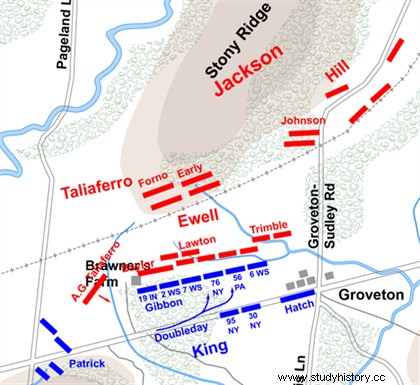 La bataille de Groveton (ou Brawner's Farm), 28 août 1862. Carte de Hal Jespersen (www.cwmaps.org) .
La bataille de Groveton (ou Brawner's Farm), 28 août 1862. Carte de Hal Jespersen (www.cwmaps.org) .
Pendant que les batteries nordistes détellent leurs pièces et commencent à contrebattre l’artillerie confédérée, les deux camps font entrer en jeu leurs renforts. Gibbon étire sa brigade pour tenir une ligne allant de la ferme Brawner au village de Groveton , colmatant les brèches avec deux régiments de la brigade Doubleday. C’est la seule aide qu’il obtiendra de toute la division :Hatch a poursuivi sa route, tandis que les hommes de Patrick perdent leur sang-froid sous le feu des canons sudistes et refusent d’avancer. De son côté, Jackson va concentrer contre Gibbon pas moins de cinq brigades, celles de Baylor, Alexander Lawton, Isaac Trimble, Alexander Taliaferro – un parent de William qui lui avait succédé à la tête de sa brigade – et William Starke.
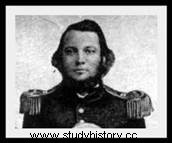 Les deux lignes s’approchent à moins de cent mètres l’une de l’autre, mais aucun des deux belligérants ne parvient à prendre l’avantage. Là où la plupart des êtres humains normalement constitués résisteraient au mieux quelques minutes avant de craquer, les soldats nordistes et leurs ennemis continuent à se fusiller à courte distance pendant plus de deux heures. En l’absence quasi complète de couvert, les pertes sont terribles :les Black Hats déplorent 148 tués, 626 blessés et 120 disparus – soit près de 900 hommes sur 2.000 présents avant le combat. En tout, 2.400 hommes sont tués ou blessés – à peu près autant de Nordistes que de Sudistes – soit un tiers des effectifs totaux engagés. Parmi les victimes, les généraux Taliaferro et Ewell sont tous deux grièvement blessés. C’est le second qui est le plus sérieusement atteint :fracassée par une balle, sa jambe gauche devra être amputée, ajoutant une jambe de bois à la déjà longue liste de ses incongruités.
Les deux lignes s’approchent à moins de cent mètres l’une de l’autre, mais aucun des deux belligérants ne parvient à prendre l’avantage. Là où la plupart des êtres humains normalement constitués résisteraient au mieux quelques minutes avant de craquer, les soldats nordistes et leurs ennemis continuent à se fusiller à courte distance pendant plus de deux heures. En l’absence quasi complète de couvert, les pertes sont terribles :les Black Hats déplorent 148 tués, 626 blessés et 120 disparus – soit près de 900 hommes sur 2.000 présents avant le combat. En tout, 2.400 hommes sont tués ou blessés – à peu près autant de Nordistes que de Sudistes – soit un tiers des effectifs totaux engagés. Parmi les victimes, les généraux Taliaferro et Ewell sont tous deux grièvement blessés. C’est le second qui est le plus sérieusement atteint :fracassée par une balle, sa jambe gauche devra être amputée, ajoutant une jambe de bois à la déjà longue liste de ses incongruités.
Le général Pope n’apprend la position réelle des troupes de McDowell que le 29 août à 5 heures du matin, lorsque le 3 ème Corps arrive à Manassas. Le V ème Corps de Fitz-John Porter s’y trouve également. Il ordonne aussitôt à ces deux corps d’armée de faire demi-tour dès que possible, afin d’aller couper la route de Jackson avant qu’il ne se retire. The 1 st Corps, qui campe non loin de Groveton, est également impliqué :il devra attaquer Jackson pour le fixer. Des renforts importants viendront à son soutien :le III ème Corps de l’armée du Potomac, ainsi que des éléments du IX ème Body. Pope ignore encore où se trouve Longstreet, mais cela ne le préoccupe guère. Il est convaincu de pouvoir prendre Jackson au piège et le détruire dans la journée. Un an, un mois et huit jours après le premier combat, le champ de bataille de Bull Run était prêt à connaître un nouvel affrontement majeur .
Premières attaques
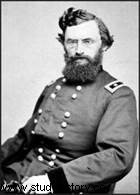 Les hommes de Franz Sigel passent la nuit sur les pentes de Henry House Hill, là-même où s’étaient livrés les plus durs combats de la bataille de l’année précédente. Ils lèvent le camp dès 5 heures 30 et marchent droit à l’ennemi, distant de quelques kilomètres seulement. La majorité des régiments du 1
er
Corps sont recrutés parmi des immigrants allemands de fraîche date ou des Américains d’origine allemande. Ils en gardent une forte identité , et pour des raisons politiques, les généraux nommés pour les commander sont souvent d’ascendance allemande eux-mêmes – à commencer par Sigel. Sensibles à l’idéologie du Free Soil et du parti républicain, ils ont appliqué avec un zèle parfois excessif les ordres de Pope relatifs à l’occupation de la Virginie. Ce faisant, ils se sont fait détester de la population locale, et leur appartenance ethnique n’a fait qu’exacerber cette réputation – la comparaison avec les « Hessois », les mercenaires allemands au service de la Grande-Bretagne durant la guerre d’Indépendance, ayant été rapidement faite.
Les hommes de Franz Sigel passent la nuit sur les pentes de Henry House Hill, là-même où s’étaient livrés les plus durs combats de la bataille de l’année précédente. Ils lèvent le camp dès 5 heures 30 et marchent droit à l’ennemi, distant de quelques kilomètres seulement. La majorité des régiments du 1
er
Corps sont recrutés parmi des immigrants allemands de fraîche date ou des Américains d’origine allemande. Ils en gardent une forte identité , et pour des raisons politiques, les généraux nommés pour les commander sont souvent d’ascendance allemande eux-mêmes – à commencer par Sigel. Sensibles à l’idéologie du Free Soil et du parti républicain, ils ont appliqué avec un zèle parfois excessif les ordres de Pope relatifs à l’occupation de la Virginie. Ce faisant, ils se sont fait détester de la population locale, et leur appartenance ethnique n’a fait qu’exacerber cette réputation – la comparaison avec les « Hessois », les mercenaires allemands au service de la Grande-Bretagne durant la guerre d’Indépendance, ayant été rapidement faite.
Sigel, dont le corps d’armée n’est pas au complet , dispose de sept brigades dont une de cavalerie. Il a déployé la division de Carl Schurz à droite avec deux brigades, et celle de Robert Schenck à gauche avec deux autres. Pour assurer la jonction entre les deux, la brigade indépendante mixte de Robert Milroy tient le centre. De la division d’Adolph von Steinwehr, lui-même absent, n’est disponible que la brigade de John Koltes, que Sigel tiendra dans un premier temps en réserve. Sur la gauche de ce dispositif, la division des Pennsylvania Reserves agira en flanc-garde. Tout juste transférée du V ème Corps au 3 ème , elle est à présent commandée par John F. Reynolds, qui vient de bénéficier d’un échange de prisonniers après sa capture à Gaines’ Mill. Sa mission sera surtout d’assurer la liaison avec les 3 ème et V ème Corps, dont le vaste mouvement tournant doit permettre d’envelopper les forces de Jackson.
Les III ème et IX ème Corps, pour leur part, doivent arriver incessamment de Centreville et couvrir le flanc droit de Sigel. Ne bénéficiant pas encore de leur soutien, et ne connaissant pas la position exacte et la force réelle des Confédérés, le commandant du 1 er Corps se montre initialement prudent . Si les premiers combats commencent vers 7 heures, il s’agit principalement d’escarmouches entre tirailleurs et de reconnaissances en force. De fait, Jackson, dans son rapport, ne notera rien de sérieux avant 10 heures. Sa ligne s’étend sur près de trois kilomètres, bien trop pour que le 1 er Corps nordiste puisse constituer à lui seul une menace. Sur la gauche sudiste, A.P. Hill a déployé ses six brigades sur deux lignes. Lawton, qui a succédé à Ewell, tient le centre avec quatre brigades, tandis que Starke commande désormais la division Taliaferro sur la droite – quatre brigades également. Son flanc droit est en l’air, mais Jackson a compensé ce fait en y massant la majeure partie de son artillerie.
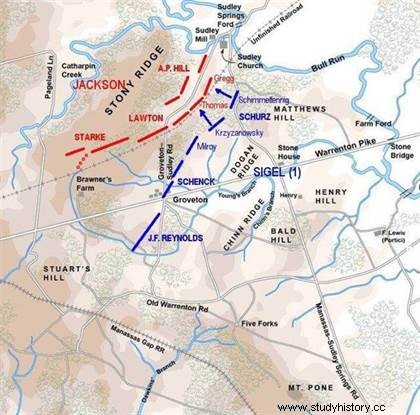 Seconde bataille de Bull Run, 29 août 1862. Situation entre 7 heures et 10 heures. Cette carte et les suivantes ont été réalisées par l'auteur sur un fond de Hal Jespersen (www.cwmaps.org).
Seconde bataille de Bull Run, 29 août 1862. Situation entre 7 heures et 10 heures. Cette carte et les suivantes ont été réalisées par l'auteur sur un fond de Hal Jespersen (www.cwmaps.org).
Durant les trois heures qui suivent, les combats gagnent progressivement en intensité. L’échelle des engagements successifs reste cependant mineure :sur le terrain, les commandants de brigade n’engagent leurs régiments que les uns après les autres. De surcroît, les différentes brigades nordistes ne se soutiennent pas entre elles et attaquent des points distincts de la ligne confédérée. Celles de la division Schurz, commandées par Wlodzimierz Krzyzanowski et Alexander Schimmelfennig, se heurtent à la gauche confédérée, essentiellement les brigades d’Edward Thomas et Maxcy Gregg. Celles-ci tiennent bon. Plutôt que de monter une défense statique, les Confédérés contre-attaquent dès qu’ils le peuvent. Sigel rapportera ainsi trois contre-attaques, et les combats de la matinée prendront l’apparence d’allers-retours incessants à travers les bois qui parsèment les abords de la voie ferrée inachevée. Les Sudistes, cependant, conservent l’avantage.
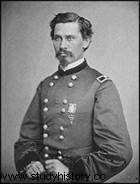 Afflux de renforts
Afflux de renforts
La bataille va prendre une nouvelle ampleur à partir de 10 heures. Tout commence avec l’arrivée des premiers éléments du III ème Corps nordiste – en l’occurrence la division Kearny et ses trois brigades. Elle vient se placer aussitôt sur la droite du dispositif fédéral, ce qui pousse Sigel à renouveler aussitôt son attaque en comptant sur le soutien de Kearny. Mais celui-ci ne viendra pas. D’ordinaire si prompt à marcher au son du canon, le bouillant sabreur restera inexplicablement l’arme au pied durant la plus grande partie de la journée. Bien que Kearny n’allait pas vivre assez longtemps pour s’expliquer sur cette inhabituelle apathie, cette dernière est aujourd’hui généralement attribuée à une inimitié personnelle entre lui et Sigel. En fin de matinée, Kearny se contentera de faire sonder l’extrémité gauche de la ligne sudiste par la brigade d’Orlando Poe, qui livrera de légères escarmouches à des éléments de cavalerie confédérés le long du Bull Run.
Il s’agit en fait de la brigade de Fitzugh Lee, tout juste arrivée. Sa présence est le signe de la venue imminente des troupes de Longstreet , dont la division de cavalerie de Stuart constitue l’avant-garde. De fait, au moment où Kearny déploie ses forces sur l’aile droite nordiste, les deux brigades de la division sudiste de John Bell Hood établissent, à l’autre bout du champ de bataille, le contact avec les forces de Jackson. Ni Lee, ni Pope ne sont encore sur le terrain en personne, et la jonction entre les deux ailes confédérées se fait à l’insu du commandant en chef nordiste. Il aurait pourtant pu en être informé plus tôt. Dès 8 heures du matin, des éléments de la brigade de cavalerie de John Buford avaient observé une importante colonne sudiste traverser le village de Gainesville, à quelques kilomètres plus à l’ouest seulement. Cette information, toutefois, ne sera rapportée à McDowell qu’en début d’après-midi, et celui-ci négligera de la transmettre à Pope jusqu’à la fin de la journée.
Pendant ce temps, les combats le long de la voie ferrée inachevée se poursuivent. Alors que la brigade Gregg rejette une nouvelle fois les Nordistes sur leurs positions de départ, Milroy parvient à s’infiltrer dans un petit vallon boisé, surnommé « the Dump », entre les brigades Lawton (à présent commandée par Marcellus Douglass) et Trimble. Celles-ci se regroupent pour contre-attaquer , et Milroy se retrouve bientôt en fâcheuse posture. Il finit par être éjecté de la brèche, mais la riposte des Confédérés leur aura néanmoins coûté Isaac Trimble. Une de ses jambes est passablement déchiquetée par une balle Minié et le général sudiste évitera de justesse l’amputation.
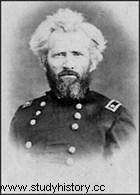 Pour soutenir Milroy en plein recul, Sigel ordonne à Schenck de se porter à son secours. Jusque-là, sa division n’a guère été engagée, la concentration de canons sudistes dans son secteur l’ayant dissuadé d’attaquer plus franchement. Les deux brigades de Schenck, commandées respectivement par Julius Stahel et Nathaniel McLean, ne progresseront guère, toujours par la même raison :l’artillerie confédérée les accueille par un feu nourri et menace de les prendre en enfilade durant leur marche d’approche. Engagé à son tour pour soulager Schenck, Reynolds fera preuve de la même prudence. Il se contentera de faire avancer une de ses batteries, sous la protection de la brigade Meade. Après 10 heures 30, la bataille se limitera dans ce secteur à un duel d’artillerie. Sigel, pour sa part, stoppera la contre-attaque sudiste en engageant la brigade Koltes et en faisant un usage judicieux de sa propre artillerie.
Pour soutenir Milroy en plein recul, Sigel ordonne à Schenck de se porter à son secours. Jusque-là, sa division n’a guère été engagée, la concentration de canons sudistes dans son secteur l’ayant dissuadé d’attaquer plus franchement. Les deux brigades de Schenck, commandées respectivement par Julius Stahel et Nathaniel McLean, ne progresseront guère, toujours par la même raison :l’artillerie confédérée les accueille par un feu nourri et menace de les prendre en enfilade durant leur marche d’approche. Engagé à son tour pour soulager Schenck, Reynolds fera preuve de la même prudence. Il se contentera de faire avancer une de ses batteries, sous la protection de la brigade Meade. Après 10 heures 30, la bataille se limitera dans ce secteur à un duel d’artillerie. Sigel, pour sa part, stoppera la contre-attaque sudiste en engageant la brigade Koltes et en faisant un usage judicieux de sa propre artillerie.
Peu avant midi, la division de tête du IX ème Corps nordiste, celle d’Isaac Stevens, arrive à son tour à pied d’œuvre avec trois brigades. Sigel, qui est toujours l’officier le plus élevé en grade présent sur le terrain, y voit une excellente occasion de renverser la situation. Il place les hommes de Stevens de part et d’autre de la position tenue par Milroy et ordonne une nouvelle attaque . Il demande également l’appui de Kearny, et ce dernier reçoit un ordre explicite en ce sens de la part de son supérieur direct, Heintzelmann. Derechef, Kearny ne bougera pratiquement pas. Son action pendant l’attaque à venir se limitera à des accrochages entre tirailleurs sur le front de la brigade de David Birney. Pendant ce temps, les hommes de Sigel et de Stevens réussissent à refouler les Confédérés jusque derrière la voie ferrée inachevée, mais ne parviendront pas à la franchir. Lorsque cette action prend fin, la seconde bataille de Bull Run marque une première pause.
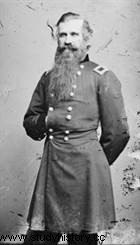 Un ordre contradictoire
Un ordre contradictoire
À peu près au même moment, Pope arrive en personne sur le champ de bataille. Il ordonne au III ème Corps de relever le 1 er , très éprouvé par les combats de la matinée. En conséquence, Kearny étend ses lignes sur sa gauche en déployant la brigade de John C. Robinson. Dans l’heure et demie qui suit, l’autre division du III ème Corps, celle de Hooker, vient se placer à ses côtés avec trois brigades. Au centre, Pope place le IX ème Corps, dont l’effectif a été porté à cinq brigades avec l’arrivée d’une division que Jesse Reno commande personnellement. L’aile gauche, pour sa part, demeure formée par les Pennsylvaniens de Reynolds. À ce stade, Pope ne s’est aucunement départi de la confiance qui était la sienne jusque-là. Il ne se soucie nullement de Longstreet, et sa plus grande crainte est de voir Jackson parvenir à s’échapper avant qu’il soit parvenu à l’écraser complètement.
Pope ignore donc complètement que son homologue confédéré est arrivé sur le lieu des combats en même temps que lui. Lee n’est pas seul :à la mi-journée, la quasi-totalité de l’aile commandée par Longstreet est venue se placer à droite de celle de Jackson, faisant peser comme une épée de Damoclès sur le flanc gauche dégarni des Nordistes. Le général en chef sudiste est enclin à lancer en avant cette force sans plus attendre. Longstreet, toutefois, émet un avis défavorable :l’état-major confédéré ignore la position complète des Fédéraux, et une attaque prématurée pourrait exposer l’aile droite toute entière si les Nordistes sont eux-mêmes en train d’effectuer un mouvement tournant. Lee finit par se ranger à cet avis et décide d’attendre . Sa décision restera sans conséquence négative, car le gros des forces de Longstreet reste masqué à la vue des Nordistes par le relief et la végétation.
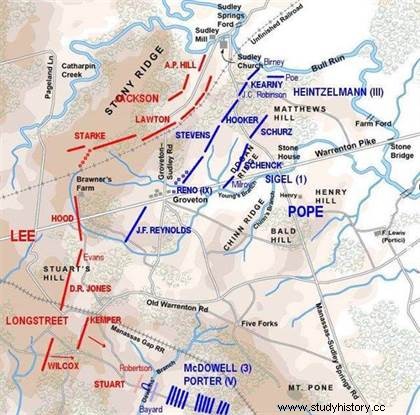 Seconde bataille de Bull Run, 29 août 1862. Situation entre 12 heures et 15 heures.
Seconde bataille de Bull Run, 29 août 1862. Situation entre 12 heures et 15 heures.
La suite des événements ne va pas tarder à donner raison à Longstreet. Aux environs de 13 heures, la brigade de cavalerie de Robertson, qui couvre l’extrémité gauche de l’armée sudiste, accroche les cavaliers fédéraux de George Bayard sur la route que relie Manassas à Gainesville. Il ne s’agit en fait que de l’avant-garde des 3 ème et V ème Corps, quatorze brigades en tout, qui effectue là le mouvement que Pope a ordonné à Porter et McDowell en tout début de matinée. Cette force formidable pourrait écraser les cavaliers sudistes sans difficulté et tourner la droite confédérée, renversant complètement la situation générale. Mais il n’en sera rien. La longue colonne nordiste « cale » et s’arrête complètement après quelques coups de canons seulement.
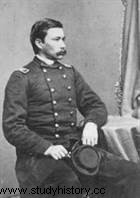 Deux facteurs principaux expliquent cette immobilisation. Le premier, qui donnera lieu à des controverses sans fin après la guerre, est Pope lui-même. L’ordre qu’il a donné à ses deux subordonnés, surnommé pour cette raison « l’ordre commun » (Joint Order ) avait été particulièrement mal formulé . À aucun moment, il ne donnait l’instruction explicite d’attaquer. Pire, il comprenait trois points principaux parfaitement contradictoires entre eux :Porter et McDowell devaient à la fois marcher en direction de Gainesville, s’arrêter dès qu’ils établiraient le contact avec Reynolds sur leur droite, et se préparer à se retirer vers l’est, en direction de Centreville… tout ceci alors que l’intention de Pope était de leur faire attaquer l’aile droite de Jackson ! Pour couronner le tout, « l’ordre commun » laissait aussi à ses destinataires toute latitude pour ne pas en exécuter les dispositions, dès lors qu’il pouvait en résulter un avantage suffisant.
Deux facteurs principaux expliquent cette immobilisation. Le premier, qui donnera lieu à des controverses sans fin après la guerre, est Pope lui-même. L’ordre qu’il a donné à ses deux subordonnés, surnommé pour cette raison « l’ordre commun » (Joint Order ) avait été particulièrement mal formulé . À aucun moment, il ne donnait l’instruction explicite d’attaquer. Pire, il comprenait trois points principaux parfaitement contradictoires entre eux :Porter et McDowell devaient à la fois marcher en direction de Gainesville, s’arrêter dès qu’ils établiraient le contact avec Reynolds sur leur droite, et se préparer à se retirer vers l’est, en direction de Centreville… tout ceci alors que l’intention de Pope était de leur faire attaquer l’aile droite de Jackson ! Pour couronner le tout, « l’ordre commun » laissait aussi à ses destinataires toute latitude pour ne pas en exécuter les dispositions, dès lors qu’il pouvait en résulter un avantage suffisant.
Dans ces conditions, on comprend que Porter et McDowell aient été poussés à improviser – ce qu’ils allaient faire, en fin de compte. Peu après que Bayard ait établi le contact, McDowell reçoit le message de Buford l’informant que les Confédérés sont présents en force à Gainesville. Sur ces entrefaites, Stuart, qui est présent en personne avec les hommes de Robertson, a recours à une ruse :« J’attendis son approche assez longtemps pour que je puisse assurer qu’il y avait là au moins un corps d’armée, tout en occupant des détachements de cavalerie à traîner des buissons le long de la route menant à Gainesville, pour tromper l’ennemi ". C’est le second facteur décisif :les nuages de poussière soulevés par ce stratagème persuadent Porter et McDowell qu’ils font face à des forces considérables, et que la position de l’ennemi est solide. Stuart gagne ainsi assez de temps pour informer Lee de la situation sur l’aile droite, et le commandant en chef sudiste peut ainsi décaler les forces de Longstreet vers la droite, en y expédiant notamment les divisions de James Kemper et Cadmus Wilcox.
- Précédent
- Suivant>>
